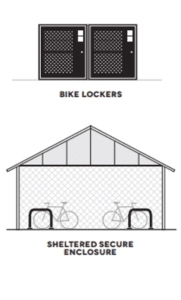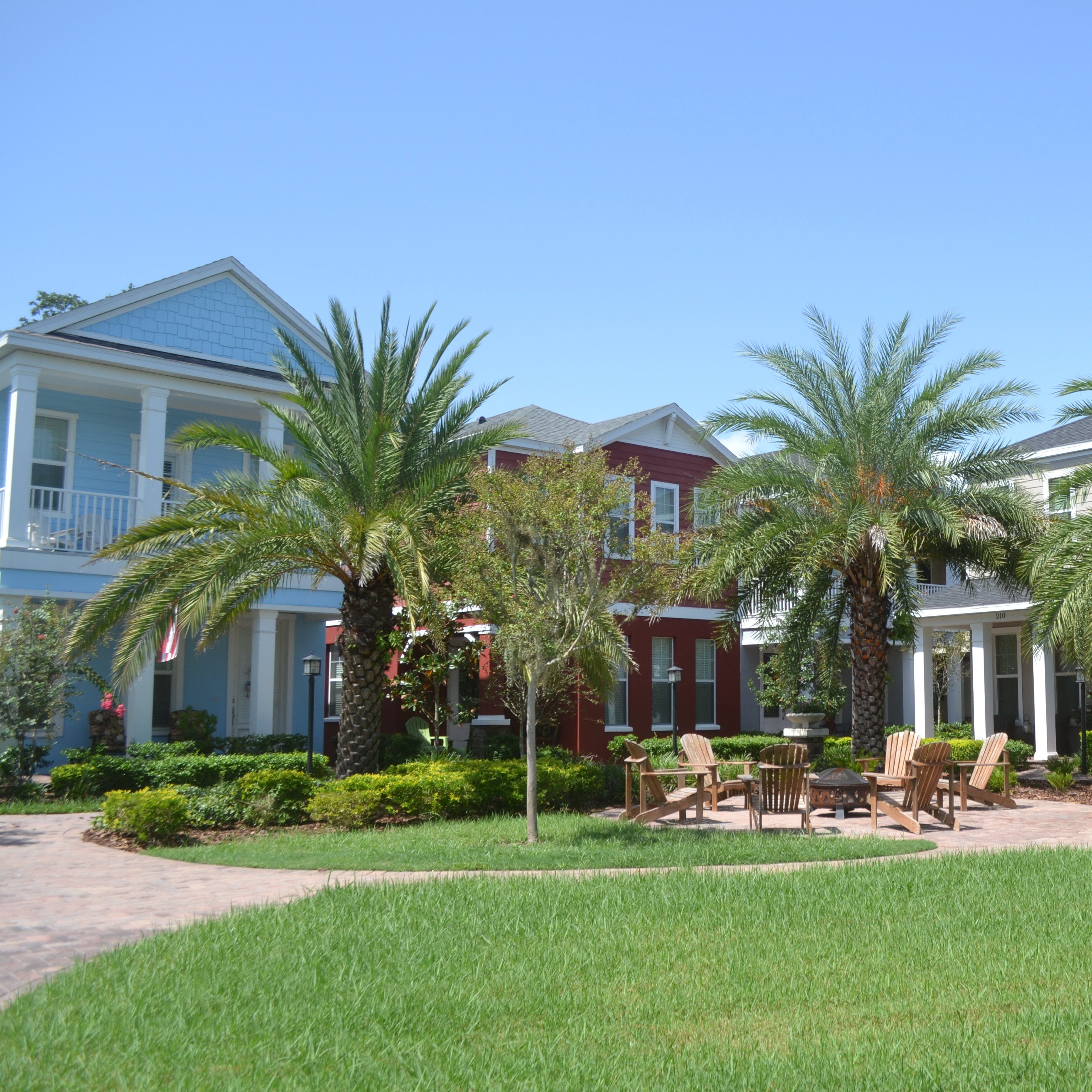
In an effort to better serve the local communities in Pinellas County, Forward Pinellas is pleased to provide the Knowledge Exchange Series. We are conducting research and providing technical assistance on topics that shape the way Pinellas County redevelops. Please visit forwardpinellas.org for future projects in the Knowledge Exchange Series.
Research on bicycle parking is essential for promoting sustainable transportation, informing urban planning and design, addressing issues of transportation equity, and promoting health and well-being. Providing people who ride bicycles a designated parking area ensures that bicycles are parked in an orderly and unobtrusive manner, playing a key role in improving cycling infrastructure as a whole, whether in public, commercial or residential settings.
Bicycle friendly infrastructure, parking, programs, and policies that support bicycling significantly increase levels of bicycling. According to a New York City Bicycle Survey, the top reason respondents do not commute to work by bicycle is due to lack of safe bicycle storage; affecting 50% of respondents.
So, how can we adapt our codes to support bicycle parking?

Project Contact: Kyle Simpson
Email: ksimpson@forwardpinellas.com
Phone: 727.464.5580
Types of Bicycle Parking

Short-Term Parking
Short-term bicycle parking is outside and typically unsheltered/unenclosed. The goal of short-term bicycle parking is to provide parking for less than two hours and is typically in the form of a bicycle rack. The primary advantage of short-term bicycle parking is high convenience as it is often located in the most central, high-traffic areas. Bicycle racks also provide a more secure option than sign poles or other street furniture to lock bicycles to, helping to reduce the chance of theft.

Long-Term Parking
Long-term bicycle parking on the other hand is far more sheltered with added protection and enclosure. Bicycles parked in long-term bicycles parking areas can be stored for extended periods of time. Long-term bicycle parking comes in the form of bicycle lockers and enclosures, which include bicycle shelters, bicycle rooms, and bicycle parking stations. The advantage of long-term bicycle parking is that it has a high level of protection against bicycle theft as it offers an enclosed space.
Bicycle Types
When designing a bicycle parking space, the wide variety of bicycle types and sizes need to be considered. Larger clearances are recommended to accommodate parking of bicycles that are longer and/or wider than a typical bicycle. Below is a visual guide to identifying different bicycles and their spacing requirements.
Bicycle Parking Spacing Guidelines
For common inverted-U and post-and-ring racks, clearances of six feet (length) x two feet (width) per bicycle are recommended, with five feet by 18-inches being the minimum standard for any vertical obstruction like walls or street trees. Since cargo bicycles and trailers extend beyond standard dimensions, requiring dedicated zones or wider individual spaces can be helpful when including them. Some cities infuse the space with color, signage, or even art to create a welcoming atmosphere that fosters community among bicyclists.
Best Practice Examples
U.S. Cities such as St. Petersburg, Kansas City, Boston, Seattle, and Charlotte have strong provisions in their development codes for bicycle parking, some of which are highlighted below. For instance, in developed areas like Pinellas County, minimum vehicular parking requirements can limit the redevelopment potential of existing developments, especially on small parcels. Allowing administrative reductions in the minimum amount of vehicular parking required by providing additional bicycle parking can facilitate economic development and reduce the barrier of variances to vehicular parking codes. The following communities provide for administrative reductions in the required minimum amount of vehicular parking.
St. Petersburg, Florida
Bicycle parking, reduction. Bicycle parking may substitute for up to 20 percent of required motor vehicle parking as set forth herein. For every six bicycle parking spaces above the minimum number of required spaces that meet the bicycle parking standards, the motor vehicle parking requirement is reduced by one space.
Portland, Oregon
In all cases, minimum parking requirements can be reduced by up to 50%, using combinations of the following provisions: One space reduction for every 5 non-required bicycle parking spaces (reduction of up to 25% of the total required parking); Three spaces for every 15-dock bicycle sharing station, with a further one-space reduction for each additional 4 docks (reduction of up to 25% of the total required parking – this provision is not currently available due to the lack of a bicycle sharing operator).
Seattle, Washington
For every two covered long-term bicycle parking spaces provided, the total parking requirement shall be reduced by one space, up to a maximum of 20 percent of the parking requirement, provided there is access to an arterial over improved streets.
Charlotte, North Carolina
When at least one hundred (100) motor vehicular parking spaces are required to serve institutional, office and industrial uses on a parcel, a reduction in required parking is permitted provided a minimum of five (5) class II (short-term) bicycle parking spaces are provided.
Minneapolis, Minnesota
The minimum automobile parking requirement for each non-residential use may be reduced ten (10) percent or one (1) space, whichever is greater, where bicycle parking spaces are provided equal to twenty-five (25) percent of the number of required automobile spaces specified in Table 541-1, Specific Off-Street Parking Requirements, but not less than four (4) bicycle parking spaces (Minneapolis, 2024).
Kansas City, Missouri
The city planning and development director may authorize up to a 15% reduction in the number of required off-street parking spaces for developments or uses that make special provisions to accommodate bicyclists. Examples of eligible accommodations include enclosed bicycle lockers, employee shower facilities, dressing areas for employees, and onsite public bicycle sharing stations. A reduction in required vehicle parking does not entitle the applicant to a reduction in required bicycle parking.
Click to view Bicycle Parking Comparison Spreadsheet.
Other Emerging Trends
- Micro-mobility integration is on the rise.
- Many cities are incorporating Electric Bicycle Charging Stations in public parks. By combining the convenience of public parks with the growing popularity of e-bicycles, smart electric bike charging stations offer an ideal solution to enhance sustainability.
- The City of Portland adopted a code requirement that 5% of bicycle parking must be near an outlet in a 2019 bike parking code update project.

Sources:
Association of Pedestrian and Bicycle Professionals (APBP) (2015). Essentials of Bike Parking. Retrieved from https://www.apbp.org/assets/docs/EssentialsofBikeParking_FINA.pdf.
Charlotte, NC. (2016). Code of Ordinances. Retrieved from https://library.municode.com/nc/charlotte/codes/code_of_ordinances/264937?nodeId=PTIICOOR_APXAZO_CH12DESTGEAP_PT2OREPALO_S12.202ABIPAST.
Kansas City, MO. (2023). Zoning and Development Code. Retrieved from https://library.municode.com/mo/kansas_city/codes/zoning_and_development_code?nodeId=ZODECOKAMI_400_SERIESDEST_88-420PALO_88-420-09BIPA.
Minneapolis, MN. (2024). Code of Ordinances. Retrieved from https://library.municode.com/mn/minneapolis/codes/code_of_ordinances?nodeId=MICOOR_TIT20ZOCO_CH541OREPALOMO_ARTIIISPOREPARE_541.320BIPARE.
MuniCode (2019). Seattle, WA Parking Requirements. Retrieved from https://www.munistandards.com/wa/seattle/parking-requirements/.
NYC Department of City Planning (2007). NYC Bike Survey [PDF]. Retrieved from https://www.nyc.gov/assets/planning/download/pdf/plans/transportation/bike_survey.pdf.
Portland Bureau of Transportation (PBOT) (2020). Bicycle Parking Code Update. Retrieved from chrome-extension://efaidnbmnnnibpcajpcglclefindmkaj/https://www.portland.gov/sites/default/files/2021/bike-parking.adopted.final-final-final.pdf.
Reliance Foundry (n.d). Why Bike Theft Matters. Retrieved from https://www.reliance-foundry.com/blog/secure-bike-parking-customers.
St. Petersburg, FL. (2024). Code of Ordinances. Retrieved from https://library.municode.com/fl/st._petersburg/codes/code_of_ordinances?nodeId=PTIISTPECO_CH26TRVE_ARTVBI.
Visit St. Pete/Clearwater (2024). St. Petersburg Black History Bike Tour. Retrieved from https://www.visitstpeteclearwater.com/event/st-petersburg-black-history-bike-tour/47426.









